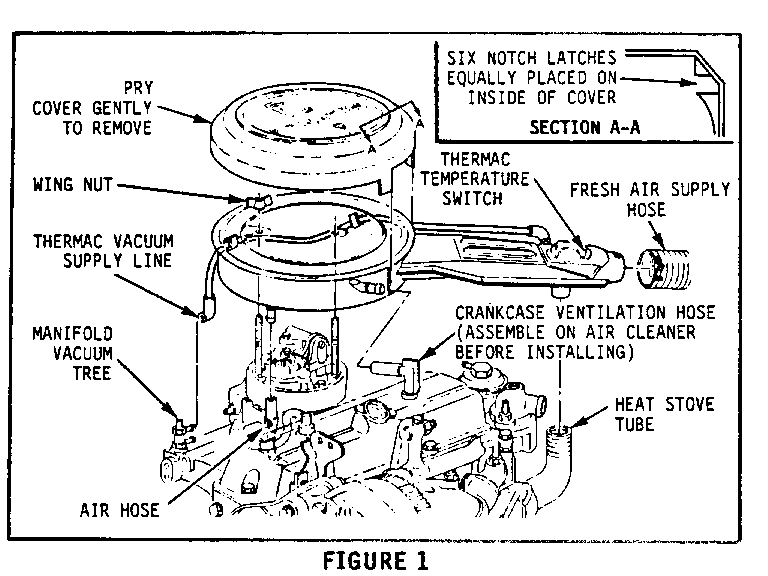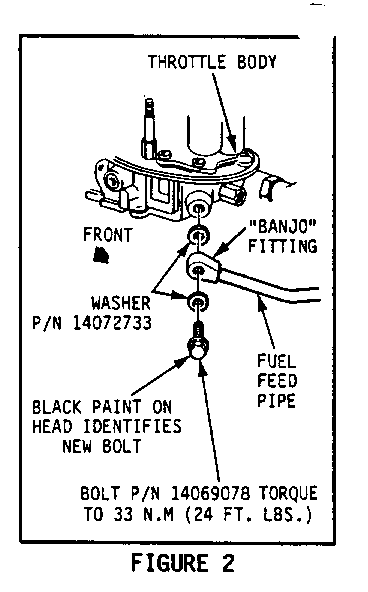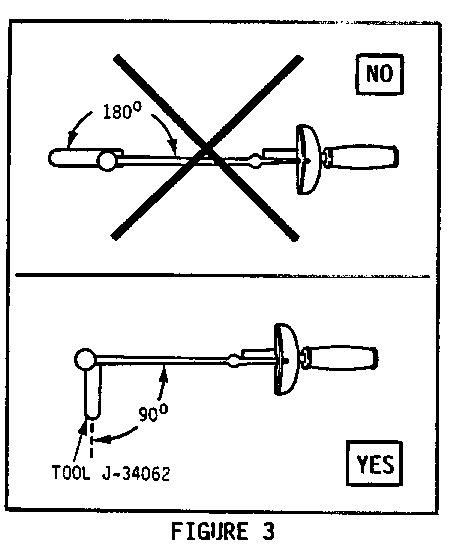CAMPAIGN: FUEL LEAK AT TBI FUEL FEED PIPE CONNECTION

SUBJECT: 1983 CIMARRON FUEL LEAKAGE AT THROTTLE BODY FUEL FEED PIPE CONNECTION
The National Traffic and Motor Vehicle Safety Act, as amended, provides that each vehicle which is subject to a recall campaign of this type must be adequately repaired within a reasonable time after the owner has tendered it for repair. Failure to adequately repair within 60 days after tender of a vehicle is prima facie evidence of failure to repair within a reasonable time. If the condition is not adequately repaired within a reasonable time, the owner may be entitled to an identical or reasonably equivalent vehicle at no charge or to a refund of the purchase price less a reasonable allowance for depreciation.
In order to avoid having to provide these burdensome solutions, every effort must be made to promptly schedule an appointment with each owner and to repair their vehicle as soon as possible. As you will see in reading the attached copy of the letter which is being sent to owners, the owner is being instructed to contact the nearest Cadillac Zone Office if the dealer does not remedy the condition within five days of the mutually agreed upon service date. If the condition is not remedied within a reasonable time, the owner is instructed on how to contact the National Highway Traffic Safety Administration.
Defect Involved
General Motors has determined that a defect which relates to motor vehicle safety exists in certain early production 1983 Cimarron vehicles equipped with 2.0 liter engines. The fuel system in these vehicles may leak at the throttle body fuel feed pipe connection. Under certain conditions this could result in an underhood fire. Such a fire could, in time, spread to the passenger compartment and cause burn injuries to occupants remaining in the vehicle.
To prevent the possibility of this occurring on the vehicles involved, dealers will be required to inspect and, if necessary, install an improved fuel feed pipe fitting bolt and two new sealing washers (gaskets) according to the service procedure in this bulletin.
Vehicles Involved
All 1983 Cimarrons equipped with the 2.0 liter engine within the following VIN range require this campaign (Cadillac records indicate that a total of 1,714 vehicles are affected):
DJ400001 through DJ401714
Owner Notification
Owners of all affected vehicles will be notified by Cadillac of this campaign. A copy of the owner letter is attached. A list of those vehicles involved, which our records indicate were sold by you, is enclosed for your follow-up. This listing contains owner names and addresses obtained from Cadillac delivery records. You are urged to limit the use of this listing for the follow-up necessary to complete this campaign.
Parts Information
The parts required to complete this campaign will be packaged in kit form and will be distributed to dealers with affected vehicles directly from Cadillac Central Office on a no charge basis. Additional kits will be made available to zone offices. Each kit will consist of the following parts:
Part Number Quantity Description
14069078 1 per vehicle Bolt 14072733 2 per vehicle Washer (gasket)
Parts are not to be ordered or returned to the Parts Distribution Centers of the Warehousing and Distribution Division of General Motors (GMWDD).
Special Tools
As indicated in the service procedure included in this bulletin, it is necessary to use Kent-Moore torque wrench adapter J-34062 (1983 essential tool) in servicing the 1983 Cimarron fuel feed pipe connection to the throttle body.
The subject tool will be forwarded to dealers by Kent-Moore Tool Division in the near future.
Dealer Campaign Responsibility
Dealers are to perform this recall campaign, at no charge to the owner, on all affected vehicles, regardless of time, mileage, or ownership and are to correct all affected vehicles in dealer new and used car inventory prior to their sale.
Whenever a vehicle subject to this campaign is taken into your new or used car inventory in the future, you should take the steps necessary to be sure the campaign correction has been made before reselling the vehicle.
In addition, dealers are to perform the campaign on all affected vehicles as they are brought in for any kind of service until all affected vehicles have been corrected.
Service Procedure
CAUTION:
To reduce the risk of fire and personal injury, it is necessary to relieve the fuel system pressure before servicing fuel system components.
To do this:
A. Remove fuel pump fuse marked "F-PMP/ECM" from fuse block in passenger compartment.
B. Crank engine. Engine will start and run until fuel supply remaining in fuel lines is consumed. When engine stops, engage starter again for 3 seconds to assure relief of any remaining pressure.
C. With ignition "OFF", replace "F-PMP/ECM" fuse.
1. Open hood and secure in upward position. Remove air cleaner cover (plastic) and air cleaner assembly. See Figure 1.
NOTE: Care should be used when removing air cleaner base so as not to stretch (plastic) thermac vacuum supply line before disconnecting from intake manifold vacuum tree.
2. Inspect the gold colored bolt which attaches the "banjo" fitting to the throttle body. See Figure 2.
If the bolt head has a black stripe or is painted black and the new lead coated washers (gaskets) are present, proceed directly to step No. 14.
3. Remove distributor cap and rotor (for ease of use of torque wrench).
4. Remove fuel feed pipe "banjo" fitting bolt from throttle body and two nylon sealing washers (inboard and outboard). Discard bolt and washers. See Figure 2.
NOTE: Care should be taken so that fuel feed pipe is not bent or deformed.
5. Install one new lead coated washer (gasket) on the new bolt and insert into "banjo" fitting. See Figure 2.
NOTE: Do not reuse existing bolt. An improved qualified bolt is included in the parts package and can be identified by a black stripe or a black mark on the head of the bolt.
6. Install second new lead coated washer (gasket) between the "banjo" fitting and throttle body. See-Figure 2.
NOTE: On a "hot to touch" engine, it may be necessary to pull the fuel feed pipe toward the throttle cable retainer bracket to install the second lead coated washer over the "banjo" fitting bolt. Do not bend or deform the fuel feed pipe as misalignment between the "banjo" itting and throttle body seal surface may occur.
7. Finger start the fuel feed pipe "banjo" fitting bolt into the throttle body. Verify that the lead coated washers are in the proper position before tightening the bolt.
NOTE: Do not lube washers or bolt threads.
8. Attach Kent-Moore torque wrench adapter tool J-34062 (1983 essential tool) on an accurate needle readout beam-type torque wrench. Do not use a "clicker" or a dial (circular readout) type torque wrench. See Figures 3 and 4.
NOTE: To assure an accurate reading, adapter must be installed at 900 to the torque wrench.
9. Tighten "banjo" fitting bolt to 33 N.m (24 ft. lbs. or 288 in. lbs.).
NOTE: It is important that torque be applied at a slow and constant rate. Overtorquing may result in bolt failure.
10. Reinstall rotor and distributor cap.
11. Plug open vacuum fitting (thermac vacuum supply line connection) on inlet manifold vacuum tree.
12. Start engine and inspect for fuel leaks and correct as required using a new bolt and lead coated washers if necessary.
13. Stop engine and remove vacuum plug.
14. Reinstall thermac vacuum supply line to intake manifold vacuum tree and install air cleaner assembly making sure the vacuum line, routed from air cleaner retaining clip to thermac temperature switch, is not pinched between air cleaner and throttle body isolator unit. See Figure 1.
Assure that: 1) fresh air supply hose, 2) crankcase ventilation hose, and 3) heat stove tube are reinstalled to the base of air cleaner assembly.
15. Install campaign label described in this bulletin and close hood.
Campaign Completion Label
Upon completion of this campaign, a white campaign label (Cat. No. S-1015) should be affixed on a clean, dry surface of the radiator core support in an area clearly visible when the vehicle's hood is raised. Each label provides space to print in ink or type Campaign 83-C-1 and your five-digit dealer code. Dealers are to take the steps necessary to insure that the numbers are properly recorded on the label.
Credit
Credit for this campaign will be issued upon receipt of a properly prepared warranty claim as follows:
Failure Labor Labor Description Code Operation Hours SUB/MAT/TOW ----------- ---- --------- ----- ------------ Inspect only 96 V1390 .2 Inspect and install new 96 V1391 .3 0.27* bolt and lead coated washers
*Additional dealer allowance for parts handling.
The labor time listed above represents the actual time required to perform the inspection and/or correction. Dealers should apply for 0.1 additional hour for administrative allowance as "Other Labor Hours".
Dear Cadillac Owner:
This notice is sent to you in accordance with the requirements of the National Traffic and Motor Vehicle Safety Act.
General Motors has determined that a defect which relates to motor vehicle safety exists in certain early production 1983 Cimarron vehicles equipped with 2.0 liter engines. The fuel system in these vehicles may leak at the throttle body fuel feed pipe connection. Under certain conditions this could result in an underhood fire. Such a fire could, in time, spread to the passenger compartment and cause bum injuries to occupants remaining in the vehicle.
To prevent the possibility of this condition occurring on your vehicle, please contact your Cadillac dealer on or after the date shown below to arrange a service date to have your vehicle corrected. The correction involves replacement of the fuel feed pipe fitting bolt and two washers (gaskets). This service will be performed at no charge to you.
Instructions for making this correction have been sent to your dealer. Parts will be available approximately October 20, 1982. The labor time necessary to perform this correction is approximately twenty minutes. Please allow additional time for the dealer to process your order. If you take your vehicle to your dealer on the agreed service date and they do not remedy this condition without charge on that date or within five days, you should contact your nearest Cadillac Zone Office, either in person or by telephone, for assistance. The locations and telephone numbers of the zone offices are listed in your Owner's Manual. If your dealer or General Motors fails or is unable to remedy this condition without charge within a reasonable time, you may wish to notify the Administrator, National Highway Traffic Safety Administration, 400 Seventh Street, S.W., Washington, D.C. 20590.
The enclosed Owner Identification Card identifies your vehicle. Presentation of this card to your dealer will assist in making the necessary correction to your vehicle in the shortest possible time. If you have sold or traded your vehicle, please let us know by completing the postage-paid card and returning it to us. This will assist us in assuring all affected vehicles have been corrected and will eliminate the necessity for contacting you during any subsequent follow-up notifications.
We are sorry to cause you this inconvenience; however, we have taken this action in the interest of your safety and continued satisfaction with our products.




General Motors bulletins are intended for use by professional technicians, not a "do-it-yourselfer". They are written to inform those technicians of conditions that may occur on some vehicles, or to provide information that could assist in the proper service of a vehicle. Properly trained technicians have the equipment, tools, safety instructions and know-how to do a job properly and safely. If a condition is described, do not assume that the bulletin applies to your vehicle, or that your vehicle will have that condition. See a General Motors dealer servicing your brand of General Motors vehicle for information on whether your vehicle may benefit from the information.
